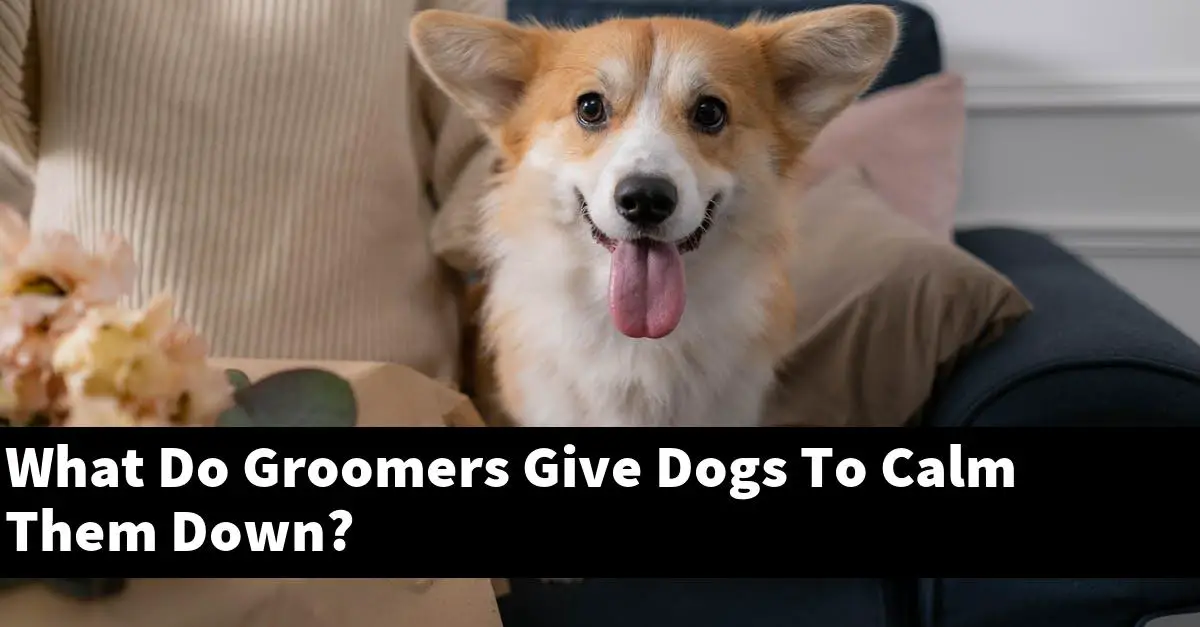Groomers often give dogs a mild sedative to help them relax during the grooming process. The sedative may be given orally or injected, and it typically takes effect within 30 minutes.
The sedative will usually make the dog drowsy and calm, but it will not put the dog to sleep.
Table of Contents
How do groomers keep dogs calm?
Grooming is a necessary task for both dogs and their owners. It is important to keep a dog calm during grooming so that the process can be done safely and efficiently.
Some factors that groomers may consider when keeping a dog calm include:
-Making sure the dog is well-rested and has had enough water
-Using positive reinforcement, such as treats, when the dog is cooperative and allows the groomer to do their job
-Using gentle, yet effective, methods of restraint, such as a muzzle or a harness, if the dog becomes agitated or aggressive
-Providing a comfortable environment, with plenty of toys and distractions, for the dog to relax in
Overall, groomers use a variety of techniques to keep dogs calm and comfortable during the grooming process. By paying attention to the individual dog, and using a variety of techniques, groomers can ensure that every dog is treated with respect and remains calm during their grooming.
What can I give my dog to calm him down before grooming?
There are a few things that can be given to a dog to calm them down before grooming. Some people might opt to give their dog a treat before they groom them, while others might give their dog a bath.
Some people might also opt to give their dog a chew toy to keep them busy while they are being groomed.
Do groomers give dogs calming meds?
Grooming can be a very stressful experience for dogs, and many groomers will offer calming medication to their customers in order to help the dogs relax. This medication can be anything from tranquilizers to muscle relaxers, and it is often administered before the grooming process begins in order to help the dog become more comfortable.
While it is definitely beneficial for the dog to be relaxed during grooming, it is important to be aware that the medication can also have side effects, so it is always best to speak with a veterinarian before giving any type of medication to a dog.
How do groomers handle hyper dogs?
Grooming for hyper dogs can be challenging. Groomers need to be careful not to aggravate the dog and cause them to become more agitated.
Some tips for handling hyper dogs include:
– start by sitting the dog down, and talking to them calmly and soothingly to get their attention
– use a calm voice and avoid yelling or making sudden movements
– use a light hand when grooming, and avoid pulling or pushing the dog
– take the time to groom one specific area at a time, and avoid handling the dog all at once
– provide plenty of toys and exercise for the dog to tire them out and reduce their energy levels
What do groomers use to sedate dogs?
Grooming professionals use a variety of methods to sedate dogs. Some of the most common methods include anesthetizing the dog with an injectable anesthetic, using a tranquilizer gun, or using a combination of both.
How do groomers deal with difficult dogs?
Grooming can be a challenging task for anyone, but it can be especially difficult for those who work with difficult dogs. Difficult dogs can be difficult to control, and may require more time and effort to groom than usual.
Some common techniques for dealing with difficult dogs include:
1. Establish clear boundaries. If a difficult dog is behaving aggressively or threateningly, it is important to establish boundaries and set limits.
This may involve physically separating the dog from the person performing the grooming, using loud and assertive commands, or using physical restraint if necessary.
2. Be prepared to be persistent. If a difficult dog is resisting grooming or is not responding to verbal commands, be prepared to be persistent.
Try different techniques, such as bribery with treats or toys, positive reinforcement, or physical restraint if necessary.
3. Be patient. Difficult dogs may take longer than usual to respond to grooming commands, and may be difficult to control.
Try not to get frustrated, and be prepared to repeat commands if necessary.
4. Be prepared to rotate grooming tasks. If a difficult dog is being difficult to groom all of the time, it may be helpful to rotate grooming tasks among different people.
This will give everyone a chance to get some work done, and will help to prevent the dog from becoming accustomed to one person being the only person who is able to groom it.
5. Be prepared to adjust techniques. If one technique is not working, be prepared to adjust your approach.
Try different verbal commands, physical restraint, or treats/toys to get the dog’s attention.
6. Be prepared to euthanize. If a difficult dog is unmanageable or dangerous, it may be necessary to euthanize it.
This may involve using physical restraint or lethal force, depending on the situation.
How do you groom a high anxiety dog?
There are a few things you can do to groom a high anxiety dog. First, start by getting the dog used to being handled.
This can be done by having the dog sit or lay down while you are holding them, and then gradually increasing the time you are holding them and doing petting. After the dog is used to being handled, begin to groom them using slow, gentle strokes.
Try to avoid making sudden movements or noises, and be sure to praise the dog when they are calm. If the dog is excessively shy or fearful, then you may need to groom them in a separate room or in a separate area of the house so they do not feel crowded or threatened.
How do you groom an unwilling dog?
Grooming an unwilling dog can be a difficult task, as they may resist being groomed or may be uncooperative. There are a few things that can be done to try and make the grooming process easier:
– Start by getting the dog comfortable with you and the grooming process. Some dogs may be more willing to be groomed if they know that it is something that you do regularly.
Try sitting down beside the dog and asking them to come to you. Once they are close, start petting them gently and telling them that you are going to groom them.
Repeat this process until the dog is comfortable with the grooming process.
– If the dog is resistant, try using a brush or comb instead of the hands. Brushing or combing the fur from the base of the tail to the end can be a gentle way to start.
Be gentle and slow at first, and increase the speed as the dog becomes more comfortable.
– If the dog is still resistant, try using a muzzle. Muzzles can be a more gentle way to force the dog to cooperate, as they are less likely to feel threatened.
Be sure to use a muzzle that is comfortable for the dog, as they may resist being groomed if it is too tight or too loose.
– If the dog is still resistant, try using a shaving cream or gel. Shaving cream or gel can be used to shave the fur off of the dog.
Be careful not to nick the skin or cause any cuts. Shaving the dog can be a gentle way to start, but it may still be necessary to use other methods to get the dog to cooperate.
Can I give my dog Benadryl to calm him down?
The decision of whether or not to give a dog Benadryl to calm them down is ultimately up to the individual dog owner. Benadryl is a medication that has been used to treat a variety of conditions, and can be effective in calming a dog down.
However, there is always the potential for side effects, so it is important to weigh the risks and benefits before giving Benadryl to a dog.
Does Petsmart sedate dogs for grooming?
Petsmart does not sedate dogs for grooming.
How can I sedate my dog to cut his nails at home?
Sedation can be used to cut nails in dogs. The dog will be sedated using an anesthetic such as propofol or etomidate.
The nails will then be cut using a nail clipper or a guillotine type device.
Conclusion
There are various ways that groomers can calm dogs down, depending on the dog’s individual personality and needs. Some common methods include using treats, petting, and speaking in a soft voice.


